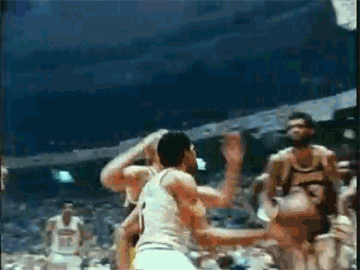Adapted from the original, which was published in 1989 in the Louisville Courier-Journal Magazine. A postscript from Glenn Stout, editor of Houghton Mifflin’s Best American Sports Writing series, follows. The story is the basis for a new opera, Approaching Ali, which debuts this weekend at the Kennedy Center in Washington D.C.
1.
I’d been waiting for years. When it finally happened, it wasn’t what I’d expected. But he’s been fooling many of us for most of our lives.
For six months, several of his friends had been trying to connect me with him at his farm in Michigan. When I finally got to see him, it wasn’t in Michigan and I didn’t have an appointment. I simply drove past his mother’s house in Louisville.
It was mid-afternoon on March 31, three days before Resurrection Day. A block-long white Winnebago with Virginia plates was parked out front.* Though he hadn’t often been in town lately, I knew it was his vehicle.
I was sure it was him because I know his patterns and his style. Since 1962, when he has traveled unhurried in this country, he has preferred buses or recreational vehicles. And he owns a second farm in Virginia. The connections were obvious. Some people study faults in the earth’s crust or the habits of storms or of galaxies, hoping to make sense of the world and of their own lives. Others meditate on the life and work of one social movement or one man. Since I was 11 years old, I have been a Muhammad Ali scholar.
I parked my car behind his Winnebago and grabbed a few old magazines and a special stack of papers I’d been storing under the front seat, waiting for the meeting with Ali I’d been certain would come. Like everyone else, I wondered in what shape I’d find The Champ. I’d heard all about his Parkinson’s syndrome and had watched him stumble through the ropes when introduced at recent big fights. But when I thought of Ali, I remembered him as I’d seen him years before, when he was luminous.
I was in my early 20s, hoping to become a world champion kickboxer. And I was fortunate enough to get to spar with him. I later wrote a couple of stories about the experience and had copies of those with me today, hoping he’d sign them.
Yes, in those days he had shone. There was an aura of light and confidence around him. He had told the world of his importance: “I am the center of the universe,” he had said, and we almost believed him. But recent reports had Ali sounding like a turtle spilled onto his back, limbs thrashing air.*
It was his brother Rahaman who opened the door. He saw the stack of papers and magazines under my arm, smiled an understanding smile, and said, “He’s out in the Winnebago. Just knock on the door. He’ll be happy to sign those for you.”
Rahaman looked pretty much the way I’d remembered him: tall as his brother, mahogany skin, and a mustache that made him look a little like a cross between footballer Jim Brown and a black, aging Errol Flynn. There was no indication in his voice or on his face that I would find his brother less than healthy.
I crossed the yard, climbed the couple of steps on the side of the Winnebago, and prepared to knock. Ali opened the door before I got the chance. I’d forgotten how huge he is. His presence filled the doorway. He had to lean under the frame to see me.
I felt no nervousness. Ali’s face, in many ways, is as familiar to me as my father’s. His skin remained unmarked, his countenance had nearly perfect symmetry. Yet something was different: Ali was no longer the world’s prettiest man. This was only partly related to his illness; it was also because he was heavier than he needed to be. He remained handsome, but in the way of a youngish granddad who tells stories about how he could have been a movie star, if he’d wanted. His pulchritude used to challenge us; now he looked a bit more like us, and less like an avatar sent by Allah.*
“Come on in,” he said and waved me past. His voice had a gurgle to it, as if he needed to clear his throat. He offered a massive hand. He did not so much shake hands as he placed his in mine. His touch was as gentle as a girl’s. His palm was cool and uncalloused, his fingers were the long, tapered digits of a hypnotist, his fingernails look professionally manicured. His knuckles were large and slightly swollen, as if he’d recently been punching the heavy bag.
He was dressed in white, all white: new leather tennis shoes, over-the-calf cotton socks, custom-tailored linen slacks, thick short-sleeved safari-style shirt crisp with starch. I told him I thought white was a better color for him than the black he often wore those days.
He motioned for me to sit, but didn’t speak. His mouth was tense at the corners; it looked like a kid’s who has been forced by a parent or teacher to keep it closed. He slowly lowered himself into a chair beside the window. I took a seat across from him and laid my magazines on the table between us. He immediately picked them up, produced a pen, and began signing. He asked, “What’s your name?” and I told him.
He continued to write without looking up. His eyes were not glazed as I’d read, but they looked tired. A wet cough rattled in his throat. His left hand trembled almost continuously. In the silence around us, I felt a need to tell him some of the things I’d been wanting to say for years.
“Champ, you changed my life,” I said.* It’s true. “When I was a kid, I was messed up, couldn’t even talk to people. No kind of life at all.”
He raised his eyes from an old healthy image of himself on a magazine cover. “You made me believe I could do anything,” I said.
He was watching me while I talked, not judging, just watching. I picked up a magazine from the stack in front of him. “This is a story I wrote for Sports Illustrated when I was in college,” I said. “It’s about the ways you’ve influenced my life.”
“What’s your name?” he asked again, this time looking right at me. I told him. He nodded. “I’ll finish signing these in a while,” he said. He put his pen on the table. “Read me your story.”
“You have a good face,” he said when I was through. “I like your face.”
He’d listened seriously as I’d read, laughing at funny lines and when I’d tried to imitate his voice. He had not looked bored. It was a lot more than I could have expected.
“You ever seen any magic?” he asked. “You like magic?”
“Not in years,” I said.
He stood and walked to the back of his RV, moving mechanically. It was my great-grandfather’s walk. He motioned for me to follow. There was a sad yet lovely, noble and intimate quality to his movements.
He did about 10 tricks. The one that interested me the most required no props. It was a very simple deception. “Watch my feet,” he said, standing maybe eight feet away, his back to me and his arms perpendicular to his sides. Then, although he’d just had real trouble walking, he seemed to levitate about three inches off of the floor. He turned to me and in his thick, slow voice said, “I’m a baadd niggah,” and gave me the old easy Ali smile.
 SEXPAND
SEXPAND
I laughed and asked him to do it again; it was a good one. I thought I might like to try it myself, just as 15 years earlier I had stood in front of the mirror in my dad’s hallway for hours, pushing my worm of a left arm out at the reflection, wishing mightily that I could replicate Ali’s cobra jab. And I had found an old cotton laundry bag, filled it with socks and rags and hung it from a ceiling beam in the basement. I pulled on a pair of my dad’s old brown cotton work gloves and pushed my left hand into that 20-pound marshmallow 200, 300, 500 times a day: concentrating on speed: dazzling, crackling speed, in pursuit of godly speed, trying to whip out punches so fast they’d be invisible to opponents. I got to where I could shoot six to eight crisp shots a second—”Shoe shinin,” Ali called it—and I strove to make my fists move more quickly than thought (like Ali’s), as fast as ionized Minute Rice; and then I’d try to spring up on my toes, as I had watched Ali do: I would try to fly like Ali, bounding away from the bag and to my left.
After the levitation trick, Ali grabbed an empty plastic milk jug from beside a sink. He asked me to examine it. “What if I make this jug rise up from the sink this high and sit there? Will you believe?”
“I’m not much of a believer these days, Champ,” I said.
“Well, what if I make it rise, sit this high off the ground, then turn in a circle?”
“I’m a hard man to convince,” I said.
“Well, what if I make it rise, float over here to the other side of the room, then go back to the sink, and sit itself back down. Then will you become … one of my believers?”
I laughed and said, “Then I’ll believe.”
“Watch,” he said, pointing at the plastic container and taking four steps back. I was trying to see both the milk jug and Ali. He waved his hands a couple of times in front of his body, said, “Arise, ghost, arise,” in a foggy-sounding voice. The plastic container did not move from the counter.
“April Fools’,” said Ali. We both chuckled and he walked over and slipped his arm around my shoulders.
He autographed the stories and wrote a note on a page of my book-length manuscript I asked him to take a look at. “To Davis Miller, The Greatest Fan of All Times,” he wrote, “From Muhammad Ali, King of Boxing.”
I felt my stories were finally complete, now that he’d confirmed their existence. He handed me the magazines and asked me into his mother’s house. We left the Winnebago. I unlocked my car and leaned across the front seat, carefully placing the magazines and manuscript on the passenger’s side, not wanting to take a chance of damaging them or leaving them behind. Abruptly, there was a chirping, insect-sounding noise in my ear. I jumped back, swatted the air, turned around. It had been Ali’s hand. He was standing right behind me, still the practical joker.
“How’d you do that?” I wanted to know. It was a question I’d find myself asking several times that day.
He didn’t answer. He raised both fists to shoulder height and motioned me out into the yard. We walked about five paces, I put up my hands, and he tossed a slow jab at me. I blocked and countered with my own. Many fighters and ex-fighters throw punches at each other or at the air or at whatever happens to be around. It’s the way we play. Ali must still toss a hundred lefts a day. He and I had both thrown our shots a full half-foot away from the other, but my adrenal gland was pumping at high gear from being around Ali, and my jab had come out fast—it had made the air sing. He slid back a half-step and took a serious look at me. I figured I was going to get it now. A couple of kids were riding past on bicycles; they recognized Ali and stopped.
“He doesn’t understand I’m the greatest boxer of all times,” he yelled to the kids. He pulled his watch from his arm, stuck it in his pants pocket. I slipped mine off, too. He’d get down to business now. He got up on his skates, danced to his left a little, loosening his legs. A couple of minutes before, climbing down the steps of his RV, he’d moved so awkwardly he’d almost lost his balance. I’d wanted to give him a hand, but knew not to. I’d remembered seeing old Joe Louis being “escorted” in that fashion by lesser mortals, and I couldn’t do that to Muhammad Ali. But now that Ali was on his toes and boxing, he was moving fairly fluidly.
He flung another jab in my direction, a second, a third. He wasn’t one-fourth as fast as he had been in 1975, when I’d sparred with him, but his eyes were alert, shining like black electric marbles, and he saw everything and was real relaxed. That’s one reason old fighters keep making comebacks: We are more alive when boxing than at almost any other time. The grass around us was green and was getting high; it would soon need its first cutting. A blue-jay squawked from an oak to the left. Six robins roamed the yard. New leaves looked wet with the sun. I instinctively blocked and/or slid to the side of all three of Ali’s punches, then immediately felt guilty about it, like being 14 years old and knowing for the first time that you can beat your dad at ping-pong. I wished I could’ve stopped myself from slipping Ali’s jabs, but I couldn’t. Reflexive training runs faster and deeper than thought. I zipped a jab to his nose, one to his body, vaulted a straight right to his chin, and was dead certain all three would have scored—and scored clean. A couple of cars stopped in front of the house. His mom’s was on a corner lot. Three more were parked on the side.
“Check out the left,” a young-sounding voice said from somewhere. The owner of the voice was talking about my jab, not Ali’s.
“He’s in with the triple greatest of all times,” Ali was shouting. “Gowna let him tire himself out. He’ll get tired soon.”
I didn’t, but pretended to, anyway. “You’re right, Champ,” I told him, dropping my hands. “I’m 35. Can’t go like I used to.”
I held my right hand to my chest, acting out of breath. I looked at Ali; his hand was in the exact same position. We were both smiling, but he was sizing me up.
“He got scared,” Ali shouted, conclusively.
Onlookers laughed from their bicycles and car windows. Someone blew his horn and one yelled, “Hey, Champ.”
“Come on in the house,” Ali said softly in my ear.
We walked toward the door, Ali in the lead, moving woodenly through new grass, while all around us people rolled up car windows and started their engines.
2.
“Gowna move back to Loovul, just part-time.”
The deep Southern melody rolled sleepily in Ali’s voice. His words came scarcely louder than whisper and were followed by a short fit of coughing.
Back to Loovul. Back to hazy orange sunsets and ancestors’ unmarked graves; back to old, slow-walking family (real and acquired), empty sidewalks, nearly equatorial humidity, peach cobblers made by heavy, round-breasted aunts wearing flowered dresses; back to short, thin uncles with their straw hats, white open-collar shirts, black shiny pants, and spit-shined black Florsheims—back to a life that hadn’t been Ali’s since he was 18 years old.
We were standing in the “family room,” a space so dark I could not imagine the drapes ever having been drawn, a room furnished with dented, gold-painted furniture, filled with smells of cooking meat, and infused with a light not dissimilar to that of a fireplace fire.
Ali had introduced me to his mother, Mrs. Odessa Clay, and to Rahaman, then suddenly he was gone.
Ali’s family easily accepted me. They were not surprised to have a visitor and handled me with ritualistic charm and grace. Rahaman told me to make myself at home, offered a root beer, went to get it.
I took a seat on the sofa beside Ali’s mother. Mrs. Clay was in her early 70s, yet her face had few wrinkles. Short, her hair nearly as orange as those Louisville sunsets, she was freckled, fragile-looking, and pretty. Ali’s face is shaped much like his mother’s. While he was fighting she was quite heavy, but she had lost what looked to be about 75 pounds over the past 10 years.
Mrs. Clay was watching Oprah Winfrey on an old wooden floor-model TV. I was wondering where Ali had gone. Rahaman brought the drink, a paper napkin, and a coaster. Mrs. Clay patted me on the hand. “Don’t worry,” she said. “Ali hasn’t left you. I’m sure he’s just gone upstairs to say his prayers.”
I hadn’t realized that my anxiety was showing. But Ali’s mother had watched him bring home puppies many times during his 46 years. “He’s always been a restless man, like his daddy,” she said. “Can’t ever sit still.”
Mrs. Clay spoke carefully, with a mother’s sweet sadness about her. The dignified clip to her voice must once have been affected, but after cometing all over the globe with Ali, it now sounded authentically British and old-money Virginian in its inflections.
“Have you met Lonnie, Ali’s new wife?” she asked. “He’s known her since she was a baby. I’m so happy for him. She’s my best friend’s daughter. We used to all travel to his fights together. She’s a smart girl, has a master’s degree in business. She’s so good to him, doesn’t use him. He told me, ‘Mom, Lonnie’s better to me than all the other three put together.’ She treats him so good. He needs somebody to take care of him.”
Just then, Ali came back to the room, carrying himself high and with stately dignity, though his footing was unsteady. He fell deep into a chair on the other side of the room.
“You tired, baby?” Mrs. Clay asked.
“Tired, I’m always tired,” he said, rubbing his face a couple of times and closing his eyes.
He must have felt me watching or was simply conscious of someone other than family being in the room. His eyes weren’t closed 10 seconds before he shook himself awake, balled his hands into fists, and started making typical Ali faces and noises at me—sticking his teeth out over his lower lip, looking fake-mean, growling, other playful cartoon kid stuff. After a few seconds he asked, “Y-y-you okay?” He was so difficult to understand that I didn’t so much hear him as I conjectured what he must have been saying. “Y-y-you need anything? They takin care of you?” I assured him that I was fine.
He made a loud clucking noise by pressing his tongue across the roof of his mouth and popping it forward. Rahaman came quickly from the kitchen. Ali motioned him close and whispered in his ear. Rahaman went back to the kitchen. Ali turned to me. “Come sit beside me,” he said, patting a bar stool to his right. He waited for me to take my place then said, “You had any dinner? Sit and eat with me.”
“Can I use the phone? I need to call home and let my wife know.”
“You got kids?” he asked. I told him I had two. He asked how old. I told him the ages.
“They know me?” he asked.
“Even the 3-year-old. He throws punches at the TV whenever I play your fights.”
He nodded, satisfied. “Bring ’em over Sunday,” he said, matter-of-factly. “I’ll do my magic for ’em. Here’s my mother’s number. Be sure to phone first.”
I called Lyn and told her where I was and what I was doing. She didn’t seem surprised. She asked me to pick up a gallon of milk on the way home. I knew she was excited for me but we had a lot of history, some of it rough, and she wouldn’t show emotion in her voice simply because I was hanging out with my childhood idol. In September 1977, when Lyn and I were in college, we skipped class, took all of the money out of our bank accounts, drove from North Carolina all the way to New York, and attended the Ali-Earnie Shavers bout at Madison Square Garden.
As we were arriving in Manhattan the morning of the bout, we ran into Ali on the street in front of the Waldorf-Astoria. Traffic stopped in all directions. Thousands of us followed him as he walked to Madison Square Garden for the weigh-in. Although several people near Ali were taller and weighed more than he, he looked bigger than anyone I had seen in my life. There was a silence around him. As if his very skin were listening. There was pushing and shoving near the outside of the circle of people around Ali. Lyn and I stood on a concrete wall above and away from the clamor and looked down on him. There was a softness, a quietude, near the center of the circle; those closest to Ali were gentle and respectful.
That night in the Garden was the first time I’d seen 20,000 people move as one organism. The air was alive with smells of pretzels and hot dogs, beer and marijuana. It was Ali’s last good fight. He was regularly hurt by Shavers and would later say that Shavers had hit him harder than anyone ever. So resounding were the blows with which Shavers tagged Ali that Lyn and I heard them, the sound arriving what seemed a full second after we saw the punches connect, as we sat a quarter of a mile from the ring up in the cheap-seat stratosphere. In the 15th round, we were all standing and not realizing that we had stood. I was trembling and Lyn was holding my hand and thousands of us were chanting, “Ahh-lee, Ahh-lee,” his name our mantra, as his gloves melded into vermilion lines of tracers and the leering jack-o’-lantern opponent finally bowed before him.
We had spent all but $40 of our money on fight tickets. We could barely buy enough gas to make it back to North Carolina. For the rest of the year we had to live off of what little money I was able to make modeling for art classes at the university. Every weekend, to pay our electric bills, we filled a laundry bag (the same one I’d used as a boxing bag) with returnable soda bottles we picked up beside highways. But, all these years later, I think we’d both do it the same way to see Ali in one of his last fights.
Now Rahaman brought two large bowls of chili and two enormous slices of white bread from the kitchen. Ali and I sat at our chairs, took spoons in our hands. He put his face down close to the bowl and the food was gone. Three minutes tops. As I continued to eat, he spoke easily to me. “I remember what it was like to meet Joe Louis and Rocky Marciano for the first time,” he said. “They were my idols. I’d seen their fights and faces so many times I felt I knew them. Want to treat you right, don’t want to disappoint you.
“Do you know how many people in the world would like to have the opportunity you’re getting, how many would like to come into my house and spend the day with me?” he said. “Haven’t fought in seven years and still get over 400 letters a week.”
I asked how people got his address.
He looked puzzled. “I don’t know,” he answered, shaking his head. “Sometimes they come addressed ‘Muhammad Ali, Los Angeles, California, USA.’ Don’t have a house in L.A. no more, but the letters still get to me.
“I want to get me a place, a coffee shop, where I can give away free coffee and doughnuts and people can just sit around and talk, people of all races, and I can go and talk to people. Have some of my old robes and trunks and gloves around, show old fight films, call it ‘Ali’s Place.'”
“I’d call it ‘Ali’s,'” I said, not believing there would or ever could be such a place but enjoying sharing his dream with him. “Just ‘Ali’s,’ that’s enough.”
“‘Ali’s’?” he repeated, and his eyes focused inward, visualizing the dream. “People would know what it was,” I said.
I asked if he had videotapes of his fights. He shook his head no.
“Well, look,” I said, “why don’t I go to a video place and see if I can rent some and we can watch them tonight. Would you like that? You want to ride with me?”
“I’ll drive,” he said.
There was a rubber monster mask in the Winnebago and I wore it on my hand on the way to the video store, pressing it against the window at stoplights. A couple of times people in cars saw the mask, then recognized Ali. Ali wears glasses when he reads and when he drives. When he saw someone looking at him, he carefully removed his glasses, placed them in his lap, made his hands into fists, and put them up beside his head.
Ali was the worst driver I’d ever ridden with—other than my alcoholic grandfather near the end of his life. Ali careened from lane to lane, sometimes riding down the middle of the highway, and he regularly switched lanes without looking or giving turn signals. I balled my fists in my lap and pretended to be relaxed. A group of teenage boys became infuriated when he pulled in front of their old, beat-up Firebird and cut them off. Three of them leaned out the windows, shooting him the finger. Ali shot it back.
At the movie store, we rented an old Godzilla movie Ali wanted to see and a tape of his fights and interviews called Ali: Skill, Brains and Guts that was written and directed by Jimmy Jacobs, the international handball champion and fight historian. Jacobs had recently died of a degenerative illness. Ali hadn’t known of Jacobs’s death until I told him.
“He was a good man,” Ali said. His voice had that same quality that an older person’s takes on who daily reads obituaries. “Did you know Bundini died?” he asked, speaking in the same tone he’d use with a friend of many years. I felt honored by his intimacy and told him that I’ve heard.
In the Winnebago on the way back to his mom’s, he said, “You’re sincere. After 30 years, I can tell. I feel it rumblin’ up from inside people.”
“I know a lot of people have tried to use you,” I said.
“They have used me. But it don’t matter. I don’t let it change me.”
I stopped by my car again on the way into Mrs. Clay’s house. There was one more picture I hoped Ali would sign, but earlier I’d felt I might be imposing on him. It was a classic head-shot in a beautiful out-of-print biography by Wilfrid Sheed that featured hundreds of wonderfully reproduced color plates.* I grabbed the book from the car and followed Ali into the house.
When we were seated, I handed him the book and he signed the picture on the title page. “To Davis Miller, From Muhammad Ali, King of Boxing,” he wrote, “3-31-88.”
I was about to ask if he’d mind autographing the photo I especially wanted, but he turned to Page 2, signed that picture, then the next page and the next. He continued to sign for probably 45 minutes, writing comments about opponents (“Get up Chump,” he wrote beside a classic photo of the fallen Sonny Liston), parents, Elijah Muhammad (“The man who named me”), Howard Cosell, spouses (“She gave me Hell,” he scrawled across his first wife’s picture), then passed the book to his mother and brother to autograph a family portrait. He even signed “Cassius Clay” on several photos from the early ’60s. He flipped twice through the book, autographing nearly every photo, pointing out annotations as he wrote.*
“Never done this before,” he said. “Usually sign one or two pictures.”
As he turned from page to page, he studied, then chose not to autograph, a youthful picture of himself with the Louisville Sponsoring Group, the collective of rich white businessmen who owned his contract (and reportedly those of several race horses) until he became Muslim. He also hesitated over a famous posed shot taken for Life magazine in 1963, in a bank vault. In this photo a wide-eyed and beaming Cassius Clay sits atop one million one-dollar bills. Ali turned to me and said, “Money don’t mean nothin,” and leafed to a picture with Malcolm X, which he signed, then posed his pen above the signature, as if prepared to make another annotation. Suddenly, though, he closed the book, looked at me dead level, and held it out at arms’ length with both hands. “I’m giving you somethin’ very valuable,” he said, handing me the biography as if deeding me the book of life.
I stared at the book in my open palms and felt I should say something, should thank him in some way. I carefully placed it on a table, shook my head slightly, and cleared my throat, but found no words.
3.
I excused myself to the bathroom, locking the door behind me. A pair of Ali’s huge, shiny black dress shoes was beside the toilet. The toe of one had been crushed, the other shoe was lying on its side. When I unlocked the door to leave, it wouldn’t budge. I couldn’t even turn the handle. After trying several times, I tentatively knocked. There was laughter from the other room. I distinctly heard Mrs. Clay’s and Rahaman’s voices. I yanked fairly hard on the door a few times. Nothing. Just when I was beginning to think I was stuck in Odessa Clay’s bathroom for the millennium, the door easily opened. I caught a glimpse of Ali bounding into a side room to the right, laughing and high-stepping like some oversized, out-of-shape Nubian leprechaun.

I peeked around the corner. He was standing with his back flat against the wall. He saw me, jumped from the room, and tickled me, a guilty-little-kid smile splashed across his features. Next thing I knew, he had me on the floor, balled up in a fetal position, tears flowing down both sides of my face, laughing. Then he stopped tickling me and helped me to my feet. Everybody kept laughing. Mrs. Clay’s face was round and wide with laughter. She looked like the mom of a Celtic imp.
“What’d you think happened to the door?” Rahaman asked. I told him I’d figured it was Ali. “Then why you turnin red?” he wanted to know.
“It’s not every day,” I said, “that I go to Muhammad Ali’s, he locks me in the bathroom, then tickles me into submission.”
Everyone laughed again. “Ali, you crazy,” Rahaman said.
Suddenly I recognized the obvious, that I’d been acting like a teenage admirer again. And that Muhammad Ali had not lost perhaps his most significant talent—the ability to transport people past thoughts and words to a world of feeling and play. Being around Ali, or watching him perform on TV, has always made me feel genuinely childlike. I looked at his family: They were beaming: Ali still flipped their switches, too.
After helping me up, he trudged off to the bathroom. Rahaman crept over from his seat on the sofa and held the door, trying to keep Ali in. The brothers pushed and tugged on the door and, when Ali got out, laughed and wrestled around the room. Then Ali threw several feathery punches at Rahaman and a few at me.
We finally slipped the Ali tape into the VCR.* Rahaman brought everyone another root beer and we settled back to watch, he to my left, Ali beside me on the right, and Mrs. Clay beside Ali. The family’s reactions to the tape were not unlike those you or I would have looking at old home movies or high-school yearbooks. Everyone sighed and their mouths arced at tender angles. “Oh, look at Bundini,” Mrs. Clay said. “Hey, there’s Otis,” Rahaman offered.
When there was footage of Ali reciting verse, everyone recited with him. “Those were the days,” Rahaman said several times, to which Mrs. Clay responded, “Yes, yes, they were,” in a lamenting lilt.
After a half-hour or so, she left the room. Rahaman continued to watch the tape for a while, pointing out people and events, but then said he was going to bed. He brought a pen and piece of paper. “Give your name and number,” he said, smiling. “We’ll look you up.”
Then it was just Ali and me. On the TV, it was early 1964 and he was framed on the left by Jim Jacobs and on the right by Drew “Bundini” Brown. “They both dead now,” he said, an acute awareness of his own mortality in his tone.
For a time, he continued to stare at the old Ali on the screen, but eventually he lost interest in peering at distant mountains of his youth. “Did my mom go upstairs? Do you know?” he asked, his voice carrying no further than mine would if I had my hand over my mouth.
“Yeah, I think she’s probably asleep.”
He nodded, stood, and left the room, presumably to check on her. When he came back he was moving heavily. His shoulder hit the frame of the door to the kitchen. He went in and came out with two fistfuls of cookies, crumbs all over his mouth. He sat beside me on the sofa. Our knees were touching. Usually, when a man gets this close, I pull away. He offered a couple cookies, yawned a giant’s yawn, closed his eyes, and seemed to go dead asleep.
“Champ, you want me to leave?” I said. “Am I keeping you up?”
He slowly opened his eyes and was back to our side of The Great Mystery. The pores on his face looked huge, his features elongated, distorted, like someone’s in an El Greco. He rubbed his face the way I rub mine when I haven’t shaved in a week.
“No, stay,” he said. His tone was very gentle.
“You’d let me know if I was staying too late?”
He hesitated slightly before he answered. “I go to bed at 11,” he said.
With the volume turned this low on the TV, you could hear the videotape’s steady whir. “Can I ask a serious question?” I said. He nodded OK.
“You’re still a great man, Champ, I see that. But a lot of people think your mind is fried. Does that bother you?”
He didn’t hesitate before answering. “No, there are ignorant people everywhere,” he said. “Even educated people can be ignorant.”
“Does it bother you that you’re a great man not being allowed to be great?”
“Wh-wh-whatcha you mean, ‘not allowed to be great?'” he said, his voice hardly finding its way out of his body.
“I mean … let me think about what I mean … I mean the things you seem to care most about, the things you enjoy doing best, the things the rest of us think of as being Muhammad Ali, those are precisely the things that have been taken from you. It just doesn’t seem fair.”
“You don’t question God,” he said, his voice rattling in his throat.
“OK, I respect that, but … aw, man, I don’t have any business talking to you about this.”
“No, no, go on,” he said.
“It just bothers me,” I told him. I was thinking about the obvious ironies, thinking about Ali continuing to invent, and be invented by, his own mythology. About how he used to talk easier, maybe better, than anybody in the world (has anyone in history so enjoyed the sweet and spiky melodies of his own voice?); about how he sometimes still thought with speed and dazzle, but it took serious effort for him to communicate even with people close to him. About how he may have been the world’s best athlete—when walking, he used to move with the grace of a leopard turning a corner; now, at night, he stumbled around the house. About how it was his left hand, the same hand from which once slid that great Ali snake-lick of a jab—the most visible phenomenon of his boxing greatness—the very hand with which he won more than 150 sanctioned fights and countless sparring sessions, it’s his left hand, not his right, that shook almost continuously. And I was thinking how his major source of pride, his “prettiness,” remained more or less intact. If Ali lost 40 pounds, in the right kind of light he’d still look classically Greek. The seeming precision with which things have been excised from Ali’s life (as well as the gifts that have been left him) sort of spooked me.
“I know why this has happened,” Ali said. “God is showing me, and showing you“—he pointed his shaking index finger at me and widened his eyes—”that I’m just a man, just like everybody else.”
We sat a long, quiet time then, and watched his flickering image on the television screen. It was now 1971 and there was footage of him training for the first Frazier fight. Our Most Public Figure was then The World’s Most Beautiful Man and The Greatest Athlete of All Times, his copper skin glowing under the fluorescents, secret rhythms springing in loose firmness from his fingertips.
“Champ, I think it’s time for me to go,” I said again and made an effort to stand.
“No, stay. You my man,” he says, and pats my leg. He has always been this way, always wanted to be around people. I take his accolade as one of the greatest compliments of my life.
“I’ll tell you a secret,” he says, and leans close. “I’m gowna make a comeback.”
“What?” I say. I think he’s joking, hope he is, but something in his tone makes me uncertain. “You’re not serious?” I ask.
And suddenly there is power in his voice. “I’m gowna make a comeback,” he repeats louder, more firmly.
“Are you serious?”
“The timing is perfect. They’d think it was a miracle, wouldn’t they?” He’s speaking in a distinct, familiar tone; he’s easy to understand. It’s almost the voice I remember from when I met him in 1975, the one that seemed to come roiling up from down in his belly. In short, Ali sounds like Ali.
“Wouldn’t they?” he asks again.
“It would be a miracle,” I say.
“Nobody’ll take me serious at first. But then I’ll get my weight down to 215 and have an exhibition at Yankee Stadium or someplace, then they’ll believe. I’ll fight for the title. It’ll be bigger than the Resurrection.” He stands and walks to the center of the room.
“It’d be good to get your weight down,” I say.
“Watch this,” he says and dances to his left, studying himself in the mirror above the TV. His clean white shoes bound around the carpet; I marvel at how easily he moves. His white clothing accentuates his movements in the dark room; the white appears to make him glow. He starts throwing punches, not the kind he’d tossed at me earlier, but now really letting them go. I’d thought what he’d thrown in the yard was indicative of what he had left. But what he’d done was allow me to play; he’d wanted me to enjoy myself.
“Look at the TV. That’s 1971 and I’m just as fast now.” One second, two seconds, 12 punches flash in the night. This can’t be real. Yet it is. The old man can still do it: He can still make fire appear in the air. He looks faster standing in front of me than do the ghostlike Ali images on the screen. God, I wish I had a video camera to tape this. Nobody would believe me.
“And I’ll be even faster when I get my weight down,” he tells me.
“You know more now, too,” I find myself admitting. Jesus, what am I saying? And why am I saying this? This is a sick man.
“Do you believe?” he asks.
“Well …” I say. God, the Parkinson’s is affecting his sanity. Look at the gray shining in his hair. The guy can hardly walk, for Christ’s sake. Just because he was my boyhood idol doesn’t mean I’m blinded to what his life is now like.
And Ali throws another three dozen blows at the gods of mortality. He springs a triple hook off of a jab, each punch so quick it trails lines of light. He drops straight right leads faster than (most fighters’) jabs, erupts into a storm of uppercuts, and the air pops, and his fists and feet whir. This is his best work. His highest art. The very combinations no one has ever thrown quite like Muhammad Ali. When he was fighting, he typically held back some; this is the stuff he seldom had to use.
“Do you believe?” he asks, breathing hard.
“They wouldn’t let you, even if you could do it,” I say, thinking, There’s so much concern everywhere for your health. Everybody thinks they see old Mr. Thanatos waiting for you.
“Do you believe?” he asks again.
“I believe,” I hear myself say.
He stops dancing and points a magician’s finger at me. Then I get the look, the smile, the one that has closed 100,000 interviews.
“April Fools’,” he says, and sits down hard beside me again. His mouth is hanging open and his breath sounds raw. The smell of sweat comes from his skin.
We sit in silence for several minutes. I look at my watch. It’s 11:18. I hadn’t realized it was that late. I’d told Lyn I’d be in by 8.
“Champ, I better go home. I have a wife and kids waiting.”
“OK,” he says almost inaudibly, looking into the distance, not thinking about me anymore, yawning the kind of long uncovered yawn people usually do among family.
He’s bone-tired, I’m tired, too, but I want to leave by saying something that will mean something to him, something that will set me apart from the two billion other people he’s met, that will imprint me indelibly in his memory and make the kind of impact on his life he has made on mine. I want to say the words that will cure his Parkinson’s.
Instead I say, “See you Easter, Champ.”
He coughs and gives me his hand. “Be cool and look out for the ladies.” His words are so volumeless and full of fluid that I don’t realize what he’s said until I’m halfway out the door.
I don’t recall picking up the book he signed, but I must have: It’s beside my typewriter now. I can’t remember walking across his mom’s yard and don’t remember starting the Volvo. But I recall what was playing on the tape deck. It was “The Promise of Living” from the orchestral suite to Aaron Copland’s The Tender Land.
I don’t forget Lyn’s gallon of milk. Doors to the grocery store whoosh closed behind me. For this time of night, there are quite a few customers in the store. They seem to move more as floating shadows than as people.
An old feeling comes across me I almost immediately recognize. The sensation is much like going out into the day-to-day world after making love for the first time. It’s that same sense of having landed in a lesser reality. And of having a secret that the rest of the world can’t see. I’ll have to wake Lyn and share the memory of this feeling with her.
I reach to grab a milk jug and catch a reflection of myself in the chrome at the dairy counter. There’s a half-smile on my face and I hadn’t realized it
Postscript
Glenn Stout, author, series editor for the Best American Sports Writing, and contributing editor at SB Nation Longform: I first read Davis Miller’s “My Dinner with Ali” in Sport magazine, where it was published in 1989. I loved everything about it; guy drives by Ali’s mother’s house in Louisville, sees Ali’s RV in front of his house, stops in … and is transformed. From the first word, it came off as a very genuine, uncontrived piece. A couple years later, when I was approached to put together a sampler for a proposed new Best American title featuring writing about sports, I immediately recalled Miller’s story, and it was one of 12 or 15 stories I submitted as examples of the kind of story I would be looking for. Nearly a decade later, when Houghton Mifflin decided to do a Best American Sports Writing of the Century, I again remembered Miller’s story, sent it forward to guest editor David Halberstam, and he liked it as much as I did. Halberstam was a huge Ali fan, thought the writing about him was particularly important, and chose the story as one of six in the volume that focused on Ali (the others were by Murray Kempton, Dick Schaap, Norman Mailer, Mark Kram, and Jim Murray—pretty good company. Miller’s story is the last in the entire collection). It was then, while securing rights, that I got to know Miller a bit. I learned that the story first appeared in the Louisville Courier-Journal‘s Sunday magazine, and before landing at Sport it had also been re-printed in a number of other Sunday magazines. More remarkably, it was the author’s first published story. Miller, whose life was changed by his embrace of martial arts and boxing as a child, went on to write books about both Ali and Bruce Lee, deftly merging his personal stories with theirs. In our interactions he was as genuine and unassuming as the character who knocked on Ali’s door. Every year or two, I re-read it and still like it as much as the first time.
Davis Miller is the author of The Tao of Muhammad Ali, which has been developed into the opera Approaching Ali, premiering this weekend at the John F. Kennedy Center for the Performing Arts in Washington D.C. Miller is at work on two books, a memoir titled High Old Love Way and a collection titled Approaching Ali: The Muhammad Ali Stories.
[Color photo via Getty Premium; picture on the couch by Howard Bingham]






























 SEXPAND
SEXPAND